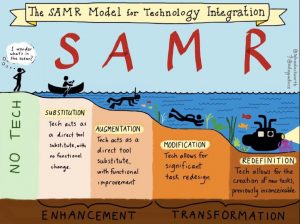I chose to analyze case 2 and case 4
Case 2: I found this case to be the most interesting of all for me because a) I am a math teacher myself and can relate to the content being discussed and b) because I have always been undecided whenever someone brought up the “allow calculators / don’t allow calculators” debate.
This video shows a passionate math teacher who has been teaching high school math for decades. He seems to be in the favor of using calculators in his math classroom unlike some math teachers out there who will not allow students to bring a calculator to class.
I think that the good use of technology in a math/science classroom is a) to make learning relevant to the current generation and b) to make learning efficient. I noticed that this teacher is achieving both of these goals by using the calculators in his classroom. As the teacher mentions towards the end of the video, the male students have poor work ethic compared to female students and when male students are given graphing calculators they tend to play around with them and figure out the problems. Therefore, the teacher is using the technology to making learning relevant for these students. This teacher is also making learning efficient for some of these students as they don’t do any work on the paper that saves them time that the teenagers would rather spend on other things than writing 20 math equations on a piece of paper. Students can simply plug in the value into the calculator and it gives them the image on the screen. Hence, the learning is made efficient by the teacher.
Drawbacks/issues: Some of the issues that came to my attention while watching these videos were: a) How old are these videos? I am guessing these cannot be very recent as it has been known that students can store a lot of data in their graphing calculators that can be used later in the tests. I am guessing these videos were made before it was discovered that they can store data.
b) The main issue I see arising, in this case, is that technology is improving and changing every day. There is always better technology out there every year. Does this mean that this teacher will have to invest money in new technology every year? Will he continue to use the old technology because it does the job? Instead of investing into calculators, which definitely seems like the right choice at this point as they are 1/10th of the cost of a computer, invest into computers where a new software or a program can be downloaded when available to help support students. Otherwise, technology can go out of date very quickly and lose its appeal to students to create relevance or making learning effiencent.
Case 4: I decided to look into case 4 as I was interested in knowing how can one use technology in a biology classroom, although there was not much offered in the video about that. However, it was interesting to hear pre-service teacher perspective on the matter of teaching technology in a science classroom.
One of the main issues I understand that came up while I was watching these videos was that the teacher was asked how does technology enhance learning in a biology classroom. And the answer that the teacher gave to this question was a bit problematic for me. He said, “use of technology does not significantly increase their achievement, but it didn’t hurt them either”. We cannot be spending time, effort and money on resources and strategies in our classrooms that are only incorporated in lessons just because they don’t help students but they don’t hurt them either. We should only use technology if it enhances student learning or even enhances half of the students’ learning in the classroom. Like in case 2, mostly male students are attracted to the idea of using calculators more than girls as they like to play with technology. I believe that before introducing anything new in your classroom, you must make the benefits of this change clear to your students. Therefore, they understand the importance of it and can benefit from it.
Gursimran Kaur
